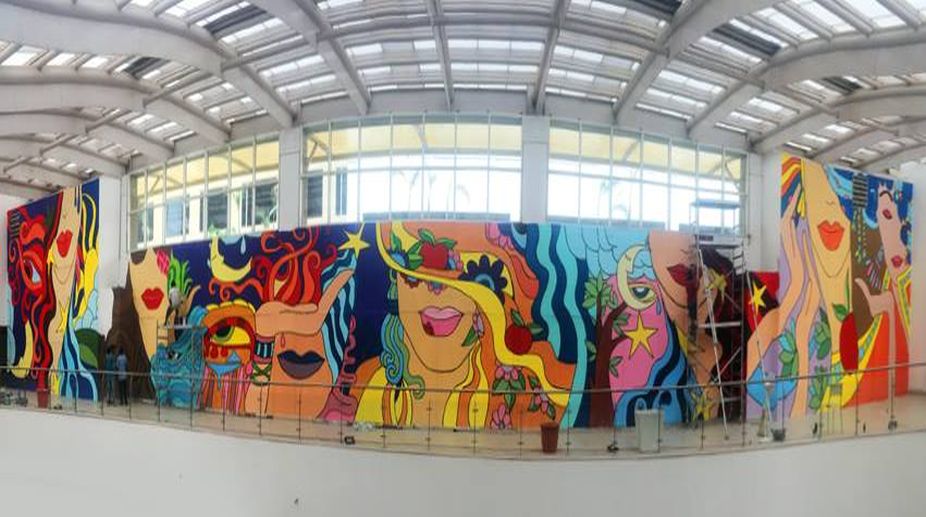LS polls: Mandarin wall graffiti, in support of Trinamool, surface in China Town
10 to 12 walls in the area have been adorned with pictorial writings in Mandarin Chinese in support of the Trinamool Congress

Representational image (Photo: Getty Images)
It is interesting to note that through the interspersing of colour ~ a welcome relief made possible through some creative endeavours ~ a rather dull concrete Metro pillar dons a cape of meticulously placed tiles, resulting in a cheerful depiction of Mother Nature.
Similarly, weathered walls encourage racing passers-by to pause, breathe and appreciate.
“Expression is natural, concrete is not”, “What did you do to make the world a better place today?”, “You may paint over me, but I will still be there”, “Change is around the corner” and many more such quotes serve the dual purpose of food-for-thought and creativity ~yet another attribute of street art. And that is not all, their contribution towards expressions, or the freedom thereof, has emerged as a powerful statement and tool. Sakshi Bhutani, a street art artist, explains, “I think there is an individual in each one of us.
Advertisement
For me, it took the right flight when I met Yogesh Saini,founder of Delhi Street Art. In a democratic country like India, I feel street art plays a vital role as it not only conveys an artistic impression but voices an expression. Challenges manifest themselves in numerous ways, which have helped me discover myself, actually.
Team work, extreme working conditions, unlearning and relearning, adaption and acceptance and so much more is what I learnt and still continue to learn. There are times when people passed by, commenting and even spitting on the works, but our motivation remained high.”
Bhutani still remembers her first encounter with street art while painting the walls in Nehru Place market, conveying the strong social message of a Clean India. She added, “I do not consider street art just as street art. It is an art and craft, even a science, with different types of painting materials and paints being used to give the piece energy and life.
For me, street art, graffiti or calligraphy are all breathers, which make me feel alive and help me serve the cause of awareness generation.”
Capital art
Bicicleta Sem Braco, a design and illustration studio, formed by Douglas de Castro and Renato Reno, both natives of Brazil, contributes designs to famous brands like Nike and Absolut, among others. Both artists recall their experience as street artists in Delhi ~ an endeavour which was unplanned. “Through our piece of work, which was in Lodhi Colony, we tried to portray the colours of Brazil through the flora and fauna.
Though it was challenging in terms of weather conditions, trying-out different palettes of colours and setting these in the design patterns was an enriching experience,” said de Castro. Reno added “Brazil and India share a number of similarities, especially in terms of vibrancy. Our work was not only a journey of art but served as a portrayal of our country too. For us, the people we interacted with, the passers-by and the responses ~ all served as an inherent part of our experience and journey.”
Needless to say, bonds are built over street art ~ connections that change lives for the better. The concept of street art was taken a step further, when renowned Mexican street-artist Senkoe, gave the Embassy of Mexico in Delhi a splash of colour through the “ajolote” ~ a beautiful, whimsical creature of Mexican fauna, and that too on the driveway wall of the Embassy ~ visible to all, and encouraging curiosity.
“The word ‘ajolote’ comes from the Nahuatl, and is a type of salamander found in Mexico. The word is associated with movement, life and transformation. Not only does it stand for something very Mexican, but the colours and patterns are inspired by the textiles of different Mexican regions,” explained Senkoe, who has also contributed to the rejuvenation of the Arjan Garh Metro station in Gurgaon as well as public spaces in villages of Himachal Pradesh and Nepal.
To him is also attributed the makeover of the official vehicle of the Ambassador of Mexico, Melba Pria. What inspires him? “It is a passion,” he said.
Besides this, he thanked people for their motivating feedbacks received for beautifying public spaces and conveying social messages. He added, “The ‘ajolote’ is an endangered species. Respect for each other, including all forms of life, is the message I want to communicate through this work of mine.”
Message on walls
Pablo Ramirez Arnol, an artist from Argentina, cites another very important advantage that street art contributes.
“My work is community-centric. I work with people who live in the area where the mural will be set-up. This leads to involvement of one and all, as well as a feeling of oneness and ownership due to the team work involved. Also, I do not use cans or sprays. It is a traditional style which I adopt.” So, how has his endeavour in India shaped-up? “I have been working in Mumbai: Bombay Central Station and Byculla Zoo. I have some projects coming-up in Delhi too. It makes it also interesting for me to explore different cities and techniques, thereby for example, one can experiment with different material like ceramics and direct coloured cement, among many others.”
As Arnol rightfully said, “There is famous quote by an Argentinian writer which goes ‘Walls are the printing press of the people’. This is a clear indication that art is a central expression in modern life, almost anywhere.”
“Imagine a city where graffiti and street art was not illegal, a city where everybody could draw wherever they liked; where every street was awash with a million colours and little phrases. Imagine a city like that…and stop leaning against the wall ~ it’s wet.”
These words by Banksy couldn’t hold more truth in a world that could be free to express and a world that learns to appreciate.
Advertisement